How to manage colostrum and minimise calf losses
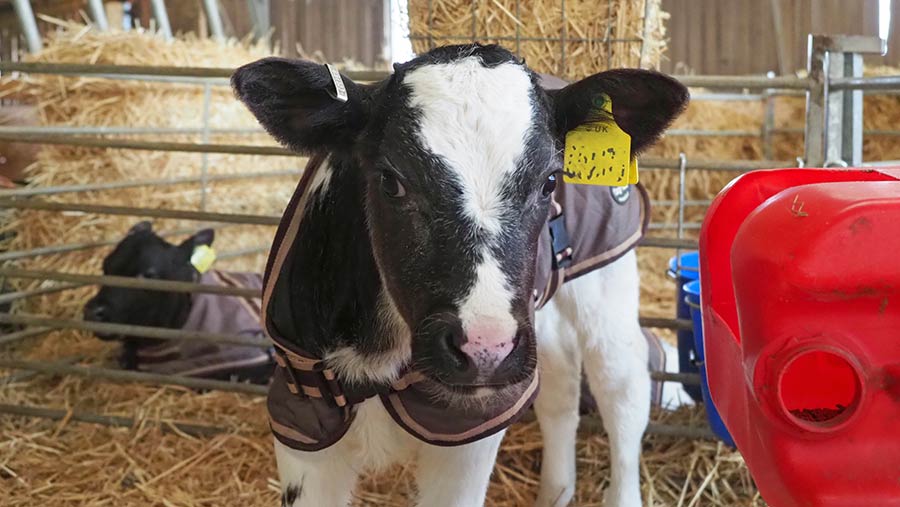 © Geoff Moore/BillyPix
© Geoff Moore/BillyPix Father and son Derek and Adam Smith are keeping calf losses to a minimum by maintaining a closed herd, managing cow body condition and being extra vigilant at calving.
Their spring-calving suckler herd usually calves outside and in 2017 calf losses from calving to weaning were kept to just two animals (1.6%).
However, this spring, the poor weather forced the herd to calve inside and despite maintaining good standards of cleanliness and assistance, their loss rate crept up to five animals (4%), which both felt was too high.
With vet Ben Barber of Synergy Farm Vets, they measured colostrum transfer to calves to see if this was an area they could improve next year. Results showed one in five calves didn’t have sufficient colostrum, with records at calving flagging up that the majority of these calves had difficulty during calving, were larger than the average calf or were less thrifty.
See also: Dairy farmer cuts vet spend while improving animal health
As a result, they started using a Brix refractometer to measure colostrum quality from cows and providing it was good enough, they bagged and froze it to ensure they had a plentiful supply. The cow’s number was written on each bag so they could trace the colostrum back to the source if required.
Although calf mortality hadn’t been an issue in previous years ( less than 2%), Mr Barber says the study showed colostrum could be a limiting factor in the suckler herd.
Derek says the study taught them to tube calves that were at a higher risk of not consuming adequate colostrum, including those they knew had been through a difficult delivery or those that were larger than average.
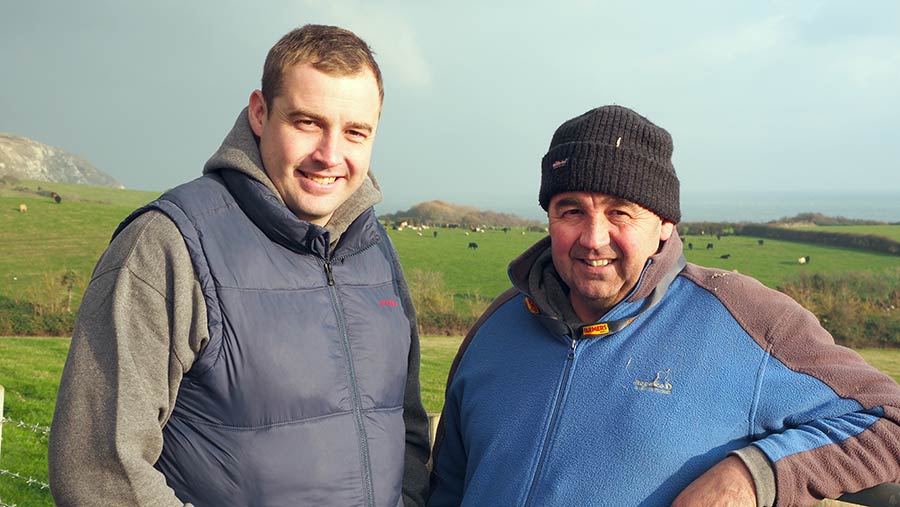
Adam and Derek Smith ©Geoff Moore/BillyPix
Whitecliff Farm facts
- 91ha rented; 40ha rented from National Trust
- 80 dairy-cross suckler cows moving to Angus cross Hereford heifers
- Recently became a closed herd; screening for infectious bovine rhinotracheitis (IBR), bovine viral diarrhoea (BVD) and leptospirosis
- Heifers are pelvic measured and AI’d to either sexed Hereford or Angus semen to breed replacements
- Rears 100 beef cross dairy calves annually
- Charolais bull used as terminal sire
- Sells stores at nine to11 months
- Lambs 60 Poll Dorsets and 40 Hebrideans – both Signet recorded
Rearing calves
Alongside the suckler herd they rear 100 beef cross dairy calves. These are bought from a neighbouring dairy farm aged two week.
The beauty of this is that they know the disease history of animals, says Derek. Calves are bovine viral diarrhoea (BVD) tag-and-tested and the herd is vaccinated and monitored against BVD, leptospirosis and infectious bovine rhinotracheitis (IBR).
“We know the suckler herd is naïve, so it is important the calves are free from disease and they are managed as two separate groups,” says Mr Barber.
Calves are fed 900g of calf milk replacers twice daily and are weaned at eight weeks once they are eating more than 2kg of concentrate.
These are currently sold as stores, but have the potential to be finished on farm.
After being awarded a Leader grant this spring, Adam and Derek purchased EID and weighing technology and hope to use this to monitor weight gains and assess how close they are to finishing animals themselves.
Thanks to Zoetis, Volac and XLVets, whose sponsorship made it possible for us to run the Rethinking Cattle Performance workshops. Farmers Weekly had full editorial control of this report.
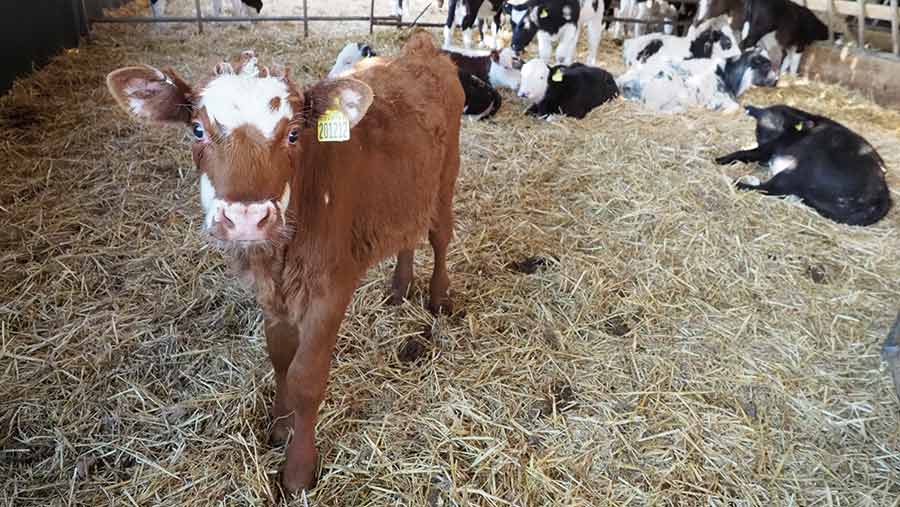
© Geoff Moore/BillyPix
Calf mortality
If calf mortality is above 2% from calving to weaning, beef farmers should work with their vet to review what could be causing it.
Speaking at the Farmers Weekly Rethinking Cattle Performance event in Swanage, Dorset, vet Ben Barber of Synergy Farm Vets said too many farmers accepted higher losses.
He showed attendees data from 40 anonymous suckler herds within the practice that calved in 2017 (90% were spring calving). It showed losses ranged from 0-14% up to weaning.
Mr Barber urged farmers not to ignore calf losses. Autumn can be a good time to assess certain aspects of spring-calving herd performance and should include a youngstock screen for infectious diseases, as well as monitoring the body condition score (BCS) of cows in order to intervene early, he said.
“Keep records at calving and look for patterns of both deaths and treatments. Which cows were the calves born from? Are individual cow factors such as BCS, age, udder and calving ease playing a part? Or is it a whole-herd problem?”
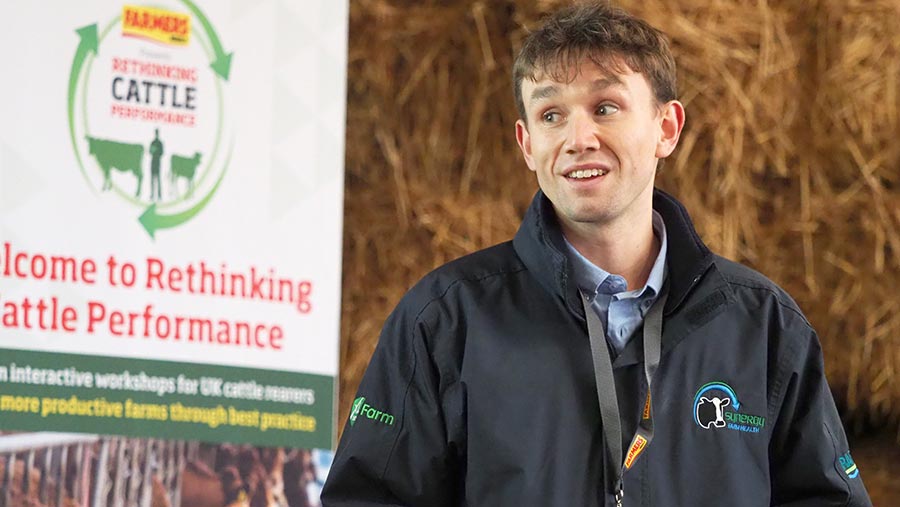
Ben Barber © Geoff Moore/BillyPix
Colostrum intake
Poor colostrum intake is one critical factor that affects calf survivability.
Calves that don’t ingest enough are three times more likely to get sick and five times more likely to die before weaning, Mr Barber explained.
Colostrum contains antibodies and other important immune system goodies that calves are able to absorb through their gut.
This absorption is most effective in the first few hours of life and gradually tails off.
The process of receiving antibodies from the calf’s mother is known as passive transfer.
Blood sampling calves within two to seven days of calving measures the total blood serum protein, which indicates how much good-quality colostrum a calf has drunk.
An ongoing study by AHDB Beef and the University of Edinburgh compared colostrum intake in 1,320 calves across 92 farms in Scotland and England by taking blood samples of calves to highlight their antibody status. The study found 15% of calves had a failure of passive transfer.
Mr Barber gives the following tips to ensure calves have enough:
1. If you think poor colostrum intake may be affecting calf health or mortality, ask your vet to blood test a group of calves to check for passive transfer.
2. If in doubt about a calf, intervene. This may involve leading the calf to its dam, using a bottle or if the calf won’t suck, tubing it.
3. Milking colostrum from the calf’s own dam in a crush and feeding it is the gold standard, but can be labour intensive. It may be better to keep a ready supply of colostrum close to hand. Cow colostrum is always best and can be taken from cows in the herd at a convenient opportunity, particularly those that may have lost their own calf. If the dam is still supporting her own calf, remember to leave enough colostrum in the cow.
4. Cow colostrum can either be stored in the fridge for a day or frozen for up to a year. Measure the quality of colostrum before freezing it using a refractometer to make sure it is worthwhile. The aim should be for it to measure more than 22% on the Brix scale. This should be thawed (not above 50C or you risk harming the antibodies) and fed at 40C.
5. If it’s not possible to harvest some, artificial colostrum replacers can be used. Remember these have consistently been shown not to have the same benefits and antibody levels as cow colostrum, but they are certainly better than nothing.
6. Be aware that obtaining colostrum from another farm poses a very high risk for the spread of disease. Even with farms that have a high health status, Johne’s remain a particular concern due to the difficulty of diagnosing the disease and the fact it can be passed from cow to calf though milk.
Top individual cow factors that may lead to poor colostrum intake and how to reduce them |
||
|
Problem |
Effect |
Preventative measures |
|
Difficult calving |
A difficult, stressful calving can lead to prolonged periods of time with no oxygen being delivered to the calf. Such calves become acidotic and show reduced vigour. |
Bull choice, BCS and culling policy are often important areas to review. |
|
Cows not within the ideal BCS range |
Both excessively thin and overconditioned cows have an increased risk of calving difficulties, along with an increased risk of failure of passive transfer. |
Aim for a target BCS at calving of 2.5 for spring calvers and 3.0 for autumn calvers.
|
|
Poor teat conformation |
|
Review culling policy. |
|
Twins |
|
While twins can be difficult to prevent, it has been shown that it has a low heritability and is associated with higher milk yields that are not always being met nutritionally. Intervention is likely to be important with these animals. |
|
Heifer |
|
An easy-calving bull is particularly important with heifers, as well as making sure they have reached their target weight at the point of calving (85% of mature weight). Pelvic measuring close to breeding is a helpful tool for sorting problem animals. |
|
Cows not having their nutritional requirements met |
There is mounting evidence that the quality of the diet during the months leading to calving has an effect on passive transfer and calf vigour. |
Ensure dry cow diet contains a minimum 9% crude protein and provides enough energy for the cow’s size and time to calving (usually 80-100MJ) as well as meeting her mineral requirements. Always bear in mind access when feed-space is limited. Your vet can take blood samples from cows four to six weeks before calving to make sure these requirements are being met. |
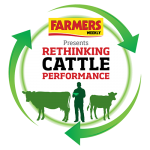 Sponsors’ message
Sponsors’ message
Zoetis, Volac and XLVets are committed to supporting UK cattle farmers in running enterprises that produce healthier, more productive animals. Part of this commitment means working with organisations such as Farmers Weekly on initiatives such as the Rethinking Cattle Performance campaign, to offer farmers the opportunity to learn from experts and their peers about the best ways to produce cattle, and particularly calves, as efficiently as possible.

